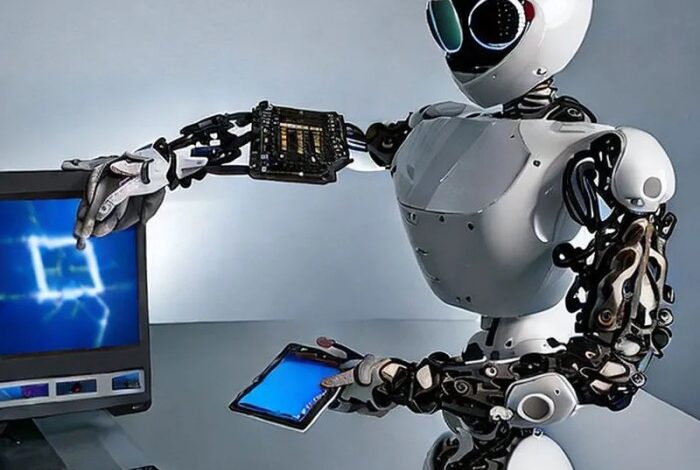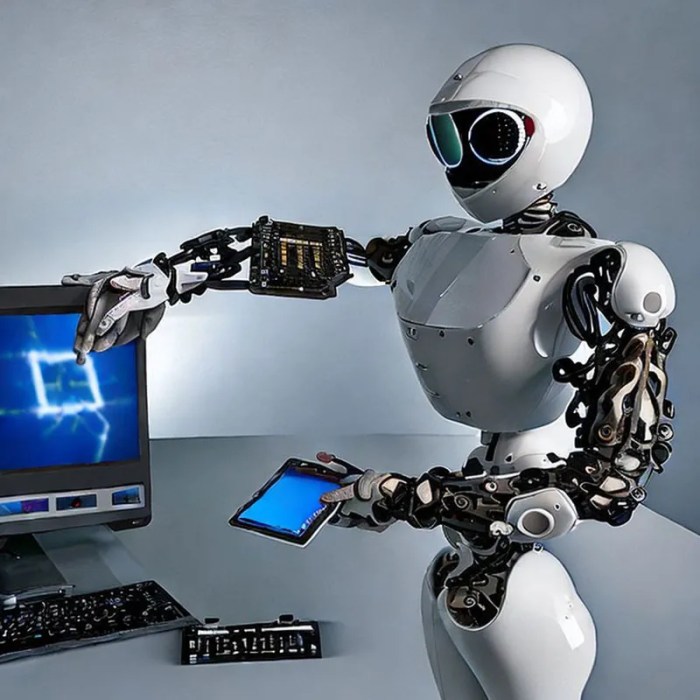
Man Made or Computer Made: Exploring the Future of Creation
Man made or computer made – it’s a question that’s increasingly relevant in our technologically advanced world. As artificial intelligence continues to evolve, we’re seeing incredible advancements in the realm of creative expression, blurring the lines between human and machine-made art.
From handcrafted furniture to AI-generated paintings, we’re presented with a fascinating spectrum of possibilities.
This exploration delves into the unique qualities of human-made objects, examining the artistry, craftsmanship, and emotional connections that imbue them with meaning. We’ll then journey into the world of computer-generated content, tracing its evolution from early digital art to the sophisticated AI-powered creations of today.
We’ll also grapple with the ethical considerations surrounding the use of AI in creative fields, exploring the impact on copyright, originality, and the potential displacement of human artists.
Exploring the Boundaries: Man Made Or Computer Made

The distinction between human-made and computer-made objects is becoming increasingly blurred as technology advances. While humans have long been the sole creators of objects imbued with intentionality, creativity, and emotional impact, computers are now capable of generating objects that challenge our traditional understanding of these qualities.
This exploration delves into the key differences between these two categories, examining the characteristics that define them and analyzing specific examples that illustrate these distinctions.
Contrasting Characteristics
The following table highlights the key differences between human-made and computer-made objects, focusing on their originality, uniqueness, and emotional resonance:
| Characteristic | Human-Made | Computer-Made |
|---|---|---|
| Originality | Often based on individual inspiration, experiences, and perspectives. | Derived from algorithms and data sets, potentially replicating existing patterns or styles. |
| Uniqueness | Typically possesses unique features and imperfections, reflecting the individuality of the creator. | May exhibit high levels of uniformity, with variations determined by algorithms. |
| Emotional Resonance | Can evoke strong emotions through personal meaning, cultural significance, or artistic expression. | May trigger emotions through aesthetic qualities or technical achievements, but lacks the depth of human connection. |
Examples of Human-Made Objects
The Mona Lisa, painted by Leonardo da Vinci, is a renowned example of a human-made object that evokes profound emotional resonance. Its enigmatic smile and captivating gaze have captivated audiences for centuries, sparking countless interpretations and discussions about the nature of human emotion and beauty.
The painting’s originality lies in da Vinci’s masterful use of sfumato, a technique that creates a sense of depth and mystery, and its uniqueness is further emphasized by its intricate details and subtle brushstrokes.
Examples of Computer-Made Objects
Deep Dream Generator, an AI-powered image generation tool, can create stunning and surreal images based on user prompts. These images often exhibit intricate patterns and vibrant colors, demonstrating the computer’s ability to manipulate visual elements in innovative ways. However, while these images may be visually captivating, they lack the emotional depth and personal connection of human-made art.
The algorithm’s reliance on data sets and predetermined patterns limits its ability to express genuine human emotion or create truly original works.
The Future of Creation
The convergence of human ingenuity and artificial intelligence is ushering in a new era of creation, where the lines between human and machine-made art are becoming increasingly blurred. As AI technologies continue to evolve, they are poised to play a transformative role in the creative process, challenging our understanding of what it means to be an artist and the very nature of art itself.
Human-Machine Collaboration in Creative Fields, Man made or computer made
The future of creation will likely be characterized by a dynamic interplay between human and machine intelligence. Artists and designers will increasingly collaborate with AI tools, leveraging their capabilities to enhance their creative output. This collaboration can take many forms, from using AI-powered tools for inspiration and ideation to co-creating works of art where human and machine contributions are intertwined.
- AI as a creative partner:Artists can use AI to generate ideas, explore different design possibilities, or even compose music or write poetry. For example, AI algorithms can analyze vast datasets of art, music, and literature to identify patterns and generate new creative outputs based on these patterns.
This can provide artists with a unique source of inspiration and help them break free from creative blocks.
- AI as a tool for augmentation:AI can be used to enhance the creative process by automating repetitive tasks, freeing up artists to focus on more conceptual and artistic aspects of their work. For instance, AI can be used to colorize black-and-white photographs, create photorealistic 3D models, or even generate intricate patterns for textiles.
- AI as a collaborator in artistic expression:AI can be used to create entirely new forms of art, pushing the boundaries of traditional artistic mediums. For example, AI-powered generative art systems can create unique and complex visual patterns, sculptures, or even musical compositions.
The Impact of AI on the Art World
The rise of AI in the art world presents both opportunities and challenges. On the one hand, AI can democratize access to creative tools and empower artists to create in ways that were previously unimaginable. On the other hand, the increasing use of AI in art raises questions about authorship, authenticity, and the value of human creativity.
- Opportunities:AI can provide artists with new tools and techniques, allowing them to experiment with different styles and mediums. It can also make art more accessible to a wider audience by automating certain aspects of the creative process. For example, AI-powered tools can be used to create personalized art experiences or to translate art into different languages.
- Challenges:The use of AI in art raises ethical concerns about the role of human creativity and the ownership of artistic works. Questions arise about who owns the copyright to AI-generated art, whether AI-generated art can be considered truly original, and whether AI can ever truly replicate the human experience of creativity.
A Hypothetical Scenario
Imagine a future where museums and galleries feature both human-made and computer-made objects, seamlessly integrated into the exhibition space. A visitor walks through a gallery, admiring a traditional oil painting, when they are suddenly drawn to a kinetic sculpture composed of intricate metal structures that respond to the visitor’s movements.
The sculpture is not just a static object but a dynamic entity, constantly evolving in response to its environment. This interactive experience blurs the lines between art and technology, inviting the visitor to engage with the artwork on a deeper level.
“The future of art is not about replacing human creativity but about augmenting it, empowering artists to push the boundaries of their imagination and create works of art that are both innovative and meaningful.”
It’s a fascinating question, isn’t it? What’s truly “man-made” and what’s just a complex algorithm? Sometimes, when I see the sheer scale of what computers can achieve, I can’t help but think back to the old adage, “Big trouble, keep telling yourself that, dad.” big trouble keep telling yourself that dad But then I remember that even the most advanced AI is ultimately a product of human ingenuity, a testament to our desire to push the boundaries of what’s possible.
It’s a constant dance, a back-and-forth between the human and the machine, and I’m eager to see where it leads us next.
It’s fascinating to think about the things we create, whether they’re handmade or computer-generated. Sometimes, the most charming things are the ones made with a little bit of human touch, like the heartwarming 36 neighbor Christmas post MMS I saw recently.
It reminded me that even in a world of digital communication, the simple act of sharing a personal message can be incredibly powerful.
Sometimes it’s hard to tell what’s truly man-made and what’s been touched by a computer, especially when it comes to things like art or design. It’s like those awesome ninja turtle ideas I found on this website , they’re so creative that you wonder if they were dreamt up by a human or a machine! But maybe that’s the beauty of it all – the lines are blurred, and the results are fantastic.

